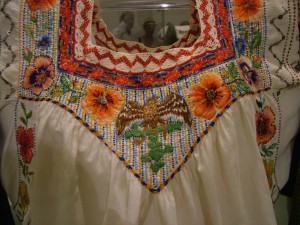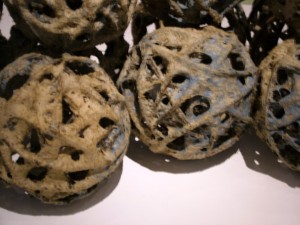On this page we are assembling materials that relate to our visit to the Museo Textil de Oaxaca (MTO).
Here’s the museum website. A small map shows how close it is to our classroom spaces. We will exit San Pablo onto Hidalgo, make a left, and we are there (917 Hidalgo). This museum occupies an eighteenth-century building that was on the grounds of the former Dominican monastery of San Pablo. It was restored by the Alfredo Harp Helú Foundation and inaugurated in 2008. Note the patterns of the tiles on the patio walls — intertextuality?

Embroidered blouse. China Poblana costume display. Note the eagle on the cactus motif, which links the story of the founding of Tenochtitlan to the modern-day Mexican national flag. (S. Wood, 2010)
The textile museum has a shop, a gallery space, a work area for educational activities with children, and a library upstairs where one can do research. We will tour whatever show will be on display in July 2014. Most shows have Mexican textiles as their focus, but some exhibitions are more global. We will also hope to be treated to an explanation and demonstration of some of the educational activities the museum employs when school groups visit. For example, the museum’s educational staff has taught youth how to decorate t-shirts with natural dyes.
It is our hope that one or more of you might take advantage of this wonderful resource and return to the museum on your own time. It is open from 10:00 to 20:00 Mondays through Saturdays and 10:00 to 18:00 on Sundays.





